Abstract
The control of micro- and nanoscale systems is a vital yet challenging endeavor because of their small size and high sensitivity, which make them susceptible to environmental factors such as temperature and humidity. Despite promising methods proposed for these systems in literature, the chattering in the controller, convergence time, and robustness against a wide range of disturbances still require further attention. To tackle this issue, we present an intelligent observer, which accounts for uncertainties and disturbances, along with a chatter-free controller. First, the dynamics of a carbon nanotube (CNT) are examined, and its governing equations are outlined. Then, the design of the proposed controller is described. The proposed approach incorporates a self-evolving neural network-based methodology and the super-twisting sliding mode technique to eliminate the uncertainties’ destructive effects. Also, the proposed technique ensures finite-time convergence of the system. The controller is then implemented on the CNT and its effectiveness in different conditions is investigated. The numerical simulations demonstrate the proposed method’s outstanding performance in both stabilization and tracking control, even in the presence of uncertain parameters of the system and complicated disturbances.
Keywords:
carbon nanotubes; Chebyshev Neural Network; self-evolving algorithm; vibration control; super-twisting sliding mode MSC:
34H05; 37N35; 93C40; 92B20
1. Introduction
CNTs have a high aspect ratio, high tensile strength, and high thermal and electrical conductivity, which makes them ideal for use in advanced materials and devices [1,2]. They have been used to create strong and lightweight materials, as well as in high-performance electronics. They can also be used as a catalyst in chemical reactions and have been studied as a potential solution for environmental problems such as air and water purification [3,4].
The control of CNTs has been an active area of research in recent years, and many studies have been conducted on developing control strategies for CNTs in different fields such as mechanical systems, chemical systems, and electrical systems [5,6]. One of the main challenges is the lack of understanding of the dynamics and properties of CNTs at the nanoscale, which can make it difficult to predict and control their behavior [7,8]. Additionally, the high aspect ratio of CNTs makes them very flexible and sensitive to external forces, which can make them difficult to control. Furthermore, the control of CNTs requires the ability to account for the effects of uncertainties and disturbances, which can be challenging [9]. Due to these issues, research in this field is ongoing and new control schemes are being developed to address these challenges [10].
Nowadays, machine learning approaches have revolutionized technologies in many fields of study. With the advancement of computing power and the availability of large datasets, machine learning algorithms can learn patterns, make predictions, and automate decision-making processes with remarkable accuracy [11]. This has led to significant breakthroughs in various fields [12,13,14]. Also, as a stepping stone in most machine learning-based techniques, neural networks have been widely used in various control applications to tackle complex and nonlinear systems [15,16]. For instance, Chen et al. [17] have used neural networks in their study to identify the generalized kernel representations and to design the intelligent fault diagnosis schemes. Neural networks are also used to approximate the mathematical model of the system and improve the control performance [18,19]. The ability of neural networks to learn and generalize from data makes them particularly useful in the control of systems that are difficult to model or have a large number of uncertain parameters [20,21]. In the control of nano/microsystems, neural networks have been used to compensate for the effects of uncertainties and disturbances on the system’s behavior. They can also be used to estimate the system’s dynamic, which can be used to improve the performance of the system [22,23]. Neural networks can be used in combination with traditional control methods such as feedback control, adaptive control, and model predictive control to improve control performance [24]. Furthermore, neural networks can also be used in the identification of system parameters, which can be used to improve the accuracy of the control strategy [25].
Some of the achievements in the literature include the development of control schemes that can effectively deal with the small size and unique properties of CNTs. For instance, recently in [26], an adaptive sliding mode control scheme has been developed which is able to work well under highly uncertain cases in which all parameters are uncertain and the uncertainties cannot be separated from the control force. In that study, a double electrostatic actuators scheme has been used and a decoupling scheme that can suppress the vibration of CNTs in multiple directions has been designed. Also, in [27], piezoelectric patches have been used as sensors to measure the displacement of the beam and actuators to implement control forces for vibration control. A model-free adaptive fuzzy sliding mode controller has been utilized to suppress the vibration of the rotating CNT-reinforced composite beam. In addition, since the state vector cannot be measured for control purposes and only the piezoelectric sensor’s output is available, a model-free adaptive fuzzy sliding mode observer has been proposed here to estimate the system’s state vector. These control schemes have been successful in achieving precise control of CNTs and have been shown to have excellent performance in numerical simulations. Despite these advances, there are still areas where improvements can be made. Chattering and handling various types of uncertainties remain persistent challenges for control engineers. This is particularly true for discontinuous disturbances, which many of the existing methods are unable to effectively deal with. The high sensitivity of nanosystems means that even small disturbances can have a significant impact on their performance, and the presence of chattering can significantly detract from their performance [28]. As a result, further research is needed to develop control methods that can effectively handle chattering and deal with a wide range of uncertainties, including discontinuous disturbances, to ensure the optimal performance of nano- and microscale systems.
Motivated by the aforementioned factors, in the current study we take advantage of the universal approximation of neural networks and propose an intelligent and smooth controller for stabilization and tracking control of CNT. We use Chebyshev Neural Network (ChNN) which is a specific type of artificial neural network that utilizes the Chebyshev polynomial as the activation function [29]. It has been demonstrated to have faster convergence and superior approximation ability compared to traditional neural networks. The Chebyshev polynomial activation function can approximate the complex function to an arbitrary degree of accuracy and its simple form reduces the risk of overfitting and enhances the robustness of the network. The ChNN has been successfully used in various areas such as system identification, function approximation, and control systems, and has shown impressive results in terms of accuracy, generalization ability, and stability [30,31].
The proposed control method for CNTs tackles the challenges posed by the small size of these systems and their sensitivity to environmental factors like temperature and humidity. This approach improves the performance of the controller and makes it more robust to changes in the system’s properties. The numerical results of the implementation of the controller on CNTs are a testament to the proposed method’s superior performance. The finite-time control strategy guarantees the closed-loop system to converge to the desired state in a finite time, regardless of the initial conditions, making them more robust in unknown conditions. This feature is especially important in the case of CNTs as the properties of CNTs can change with time due to environmental factors.
The rest of the article is structured as follows: Section 2 covers the modeling and mathematical representation of a CNT. In Section 3, the design process of the controller and its guaranteed stability are discussed. Then, in Section 4, the proposed controller is applied to the system in various uncertain scenarios for stabilization and tracking control. Finally, Section 5 concludes with summarizing remarks and prospects.
2. Modeling and Mathematical Formulation of the System
This section presents an overview of the system model of the CNT and the mathematical formulation used to describe its dynamics. The governing equations of motion for the CNT and the continuum mechanics principles applied to the CNT system are also presented. The scheme of a clamped–clamped single-walled CNT that uses electrostatic actuation to transport viscous fluid is illustrated in Figure 1.
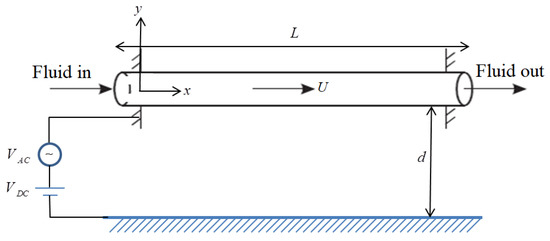
Figure 1.
An illustration of a single-walled CNT.
The tubular structure being analyzed has a slender shape and undergoes planar motions, represented by ) where is the location and is the time variable. The fluid flow velocity inside the CNT is represented by . The governing nonlinear partial differential equation (PDE) and its appropriate boundary conditions have been derived by utilizing Hamilton’s principle to study the CNT dynamics, taking into account the nonlocal effects. The following equation represents this governing equation and its corresponding boundary conditions [32]:
where signifies the length of the CNT, while represents its flexural rigidity. The viscoelastic nature of the CNT is denoted by c, and its Poisson ratio is shown as υ. The CNT’s mass per unit length is indicated by m, and the impact of the nonlocal elastic stress field on its behavior is symbolized by . The static tension in the pipe is designated as N. For the fluid being conveyed at the end of the CNT, A stands for the cross-sectional area, M for its mass per unit length, r for its viscosity, and P for its internal pressure. The external electrostatic force affecting the CNT is represented by [33].
In the equation, is the permittivity of the vacuum coefficient, with a value of (C2/Nm2). The applied electrostatic voltage is represented by , and the distance between the two electrodes is represented by . The nonlinear PDE governing the CNT (1) was converted into a dimensionless form using the following dimensionless quantities.
These non-dimensional parameters are used to simplify the equation of motion and make it easier to analyze. By expressing the variables in a dimensionless form, it is possible to compare the results from different scenarios and to understand the underlying physics of the CNT’s behavior more clearly. This is particularly useful when studying nonlinear systems such as the CNT, as it enables one to identify and analyze the key factors that affect the system’s behavior. The dimensionless equation of motion is given by
It has been assumed that the fluid’s velocity, , fluctuates in a periodic manner. To simplify the analysis, this velocity has been transformed into a dimensionless form, which is presented as:
In the equation, the fluid’s average speed is represented by , and the amplitude and frequency of its harmonic fluctuation are represented by μ and ω, respectively.
By applying the Galerkin method to the nonlinear PDE of the CNT, the complex and highly nonlinear equation is reduced to a set of simple and manageable nonlinear ordinary differential equations (ODEs). The Galerkin method is a mathematical technique that is used to simplify the solution of partial differential equations. This makes it possible to analyze the system and gain insights into its behavior. The equation of motion was discretized using the first and most significant mode shape of the CNT. This means that only the first and most significant pattern of vibration of the CNT has been considered in the analysis. This is a common practice in the analysis of linear and nonlinear systems, as it enables one to focus on the most important aspect of the system and simplify the analysis. It means that the governing PDE is broken down into smaller parts that can be more easily solved.
where the spatial and temporal parts of the deflection of the CNT are represented by and , respectively, where satisfies the boundary conditions of the CNT.
The Taylor series has been used to express the external electrostatic force of the CNT as follows:
The Taylor series is a mathematical tool that allows one to represent a function as an infinite sum of terms, where each term is a function of one or more variables raised to a certain power. In this case, the external electrostatic force of the CNT is represented as a sum of infinite terms, each term depending on the electrostatic voltage, , and the electrode’s distance, . By expressing the external electrostatic force in this way, it becomes possible to study its properties and behavior in detail. Additionally, it allows one to analyze how the force changes as the applied voltage and distance between electrodes change. This leads to the final form of the nonlinear ODE as follows:
For more details on the parameters in Equation (9) refer to [34]. The electrostatic actuation which includes both a direct current voltage () and an alternating current harmonic voltage () component is given by:
Supposing , results in
Thus, Equation (9) can be reformulated as
in which
3. Proposed Control Methodology
In this section, a novel control method, referred to as a neural network-based finite-time super-twisting sliding mode technique, has been proposed for the vibration control of a CNT. This approach utilizes the electrostatic actuation as the implemented control signal and utilizes a neural network to accurately estimate the system’s states. The stability of the proposed controller design is also proven in this section.
The proposed technique has several advantages over traditional control methods, including its ability to effectively handle the nonlinearity and uncertainty present in the CNT system, as well as its robustness to external disturbances. Additionally, it utilizes a finite-time convergence algorithm, which ensures that the system reaches the desired equilibrium state within a finite time (not exponential convergence), regardless of initial conditions or system parameters. Furthermore, by using a self-evolving neural network, it can improve control performance by reducing the effect of measurement noise and system uncertainties.
The state space equation of the system by defining and has been rewritten as follows:
where represents the compound disturbance, which includes external disturbance and uncertainties. Without losing generality, we rewrite the general state space of the system as follows:
3.1. ChNN
A ChNN is a type of neural network that is designed to work with signals represented on a Chebyshev basis. In a ChNN, the input signal is first transformed into the Chebyshev basis using Chebyshev polynomials. Chebyshev polynomials are a set of orthogonal polynomials that are defined on a specific interval, usually [−1, 1]. They have several useful properties, such as rapid convergence and a high degree of smoothness. Using Chebyshev polynomials to represent the input signal allows the ChNN to take advantage of these properties and achieve a high degree of accuracy.
The transformed signal is then processed by the neural network, which is typically a feedforward network with one or more hidden layers. The weights and biases of the network are trained using a suitable optimization algorithm, such as backpropagation. ChNNs are particularly effective in nonlinear system modeling, where they can achieve a high degree of accuracy with a relatively small number of parameters. This is because Chebyshev polynomials are able to approximate nonlinear functions very well. Furthermore, ChNNs are able to handle signals with different scales, such as signals that contain both low-frequency and high-frequency components. Overall, a ChNN is an effective method for approximating nonlinear functions.
By taking the inputs of the ChNN as and , which are the error and its time-derivative, respectively, the calculation of Chebyshev polynomials can be done using the commonly known recursive formula:
in which the first Chebyshev polynomial is considered to be constant and equal to 1, and the second one is considered as , or , in the literature. Here we set . The basis function in the Chebyshev polynomial is considered as:
The Chebyshev polynomials are ordered by n, and the neural network has m inputs as they are illustrated in Figure 2. A non-linear function is estimated by a ChNN as
where represents the optimal weight matrix of the ChNN and represents the ChNN’s bounded approximation error.
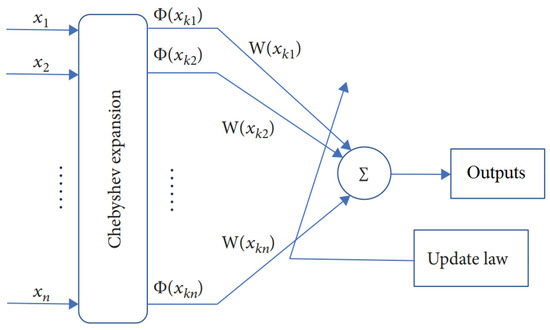
Figure 2.
The configuration of the ChNN.
3.2. Super-Twisting Finite-Time SMC
The super-twisting algorithm, introduced in [35] is a widely sliding mode control and observation technique. Here are some of the advantages of the super-twisting sliding mode controllers:
- High accuracy in controlling dynamic systems,
- Robustness against uncertainties,
- Simplicity in implementation,
- Finite-time stability properties.
In this work, we present a reliable controller for CNTs by leveraging the universal approximation capability of neural networks and the robustness of super-twisting sliding mode controllers. By combining these two powerful techniques, we aim to achieve improved control performance. The difference between the actual response and the desired response of the system is represented by the tracking error as follows:
Here, represents the desired value of the state . The sliding surface is defined as:
In this equation, the constant is a user-defined positive value. If the user-defined parameter (τ) of the sliding surface satisfies the Routh–Hurwitz stability condition, then the sliding surface will be considered stable. Our proposed solution for system (1) is a self-evolving finite-time super-twisting controller which is given by:
The parameters and are both positive used-defined parameters in this equation. Additionally, the difference between the estimated weights and the actual weights is referred to as the error of weight estimation which is given by:
As it is shown in Figure 2, the neural network needs an updating law to evolve based on the new condition. The following adaptive law describes the proposed process to evolve the weights of the neural network:
where is a positive design parameter. It is noteworthy that the proposed control technique eliminates the need for a training phase, which is typically required in many other control techniques. This means that the system can start operating immediately without any prior knowledge of the system’s dynamics or control parameters. This is achieved by using a sophisticated updating law to adjust the network’s weights based on the current state of the system and its desired output.
Theorem 1.
The control law (21) ensures that the closed-loop system states (15) attain the desired value within a specified time.
Proof.
Equation (24) represents the time derivative of the sliding surface.
In accordance with Equation (18), we know = which results in
Hence, substituting the proposed one can reach the following equations:
in which is a bounded estimation error. By introducing and as new variables and reformulating the equation, we obtain
Equation (27) represents a second-order super-twisting algorithm. According to Theorem 2 in [36] we select the following Lyapunov function
in which is a symmetric and positive definite matrix, is quadratic Lyapunov function, and in which the following equality is held for symmetric and positive definite matrix
In addition, the error trajectory will be globally ultimately bounded, and the convergence time is given by as follows:
following the procedure outlined in [36], matrices and in the Lyapunov function can be chosen, ensuring that the variables and reach zero in finite time (). □
Figure 3 depicts the process of implementing the proposed control scheme that incorporates the ChNN estimator. By leveraging the ChNN estimator and super-twisting algorithm, the proposed scheme can achieve enhanced performance even when faced with uncertainties in the model and external disturbance. In the following section, we will employ this control scheme to regulate the nonlinear dynamic of the CNT.
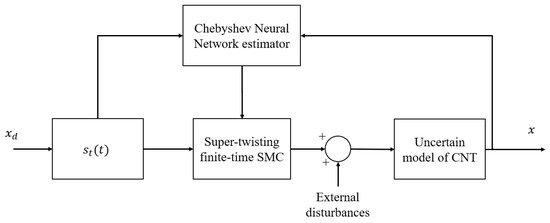
Figure 3.
The block diagram of the proposed control scheme.
4. Simulation Results
The results of numerical simulations that demonstrate the proposed control method’s outstanding performance on a CNT system are presented in this section. The system’s parameters that have been made dimensionless are = 0.001, , = 20, and . The proposed control technique’s parameters are selected using a trial-and-error approach that is notably straightforward due to the technique’s versatility across a broad range of parameters. This involves adjusting the control gains and evaluating the system’s performance until the desired level of performance is attained. However, to achieve the best possible performance with this controller, it is advisable to utilize an evolutionary algorithm like a genetic algorithm to determine the controller’s parameters. This approach considers the convergence time and control input value as objective functions to optimize the controller’s performance.
4.1. Stabilization with Uncertain Parameters
In order to take to account the effects of uncertainties, the parameters and of the system are treated as time-varying parameters and subject to unknown perturbations as follows:
The objective of this section is to maintain the stability of the CNT despite its continuously changing dynamic parameters. As shown in Figure 4, the states of the system are stabilized in a very short amount of time. This figure is meant to demonstrate that even though the parameters of the CNT system are continuously changing, the states of the system quickly stabilize and reach a stable state within a short amount of time. Figure 5, on the other hand, shows the control inputs that are applied to the CNT system in order to maintain its stability. The control signal is illustrated over time, showing the “chattering-free” behavior of the controller.
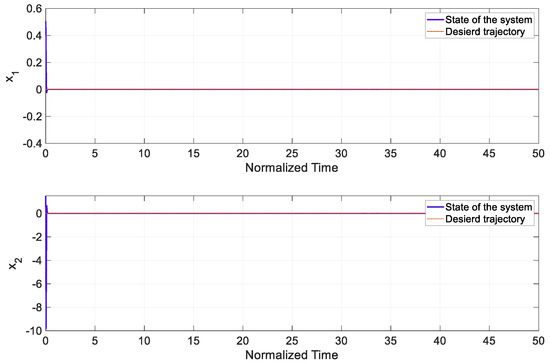
Figure 4.
The states of the CNT with uncertain parameters using the suggested control technique method.
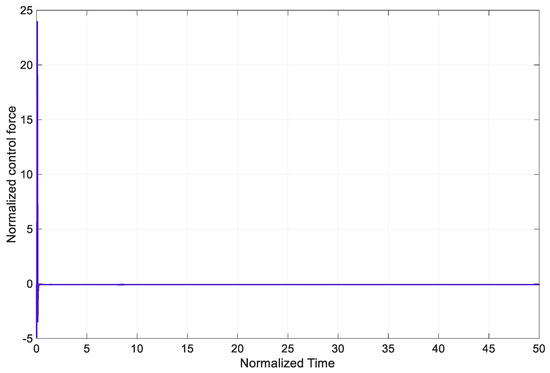
Figure 5.
The control input for the CNT with uncertain parameters.
4.2. Stabilization in the Presence of Discontinuous Disturbances
In this study, we take into account the CNT in the presence of external disturbances that are complex and change over time, such as:
The numerical results presented here effectively demonstrate the effectiveness of the proposed control strategy in maintaining the stability of the CNT system. Figure 6 clearly showcases the stabilized states of the system, even under complex disturbance conditions, highlighting the robustness of the proposed approach. Figure 7, on the other hand, presents the control signals obtained through the proposed control technique, which results in chattering-free control signals. Chattering can cause unwanted oscillations and vibrations in the system, negatively impacting its performance and reliability. The proposed control strategy, by avoiding chattering, ensures stability without sacrificing performance.
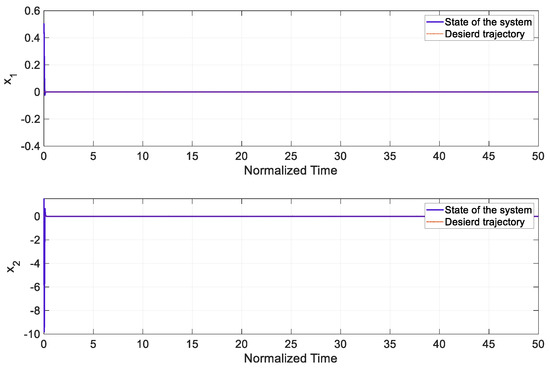
Figure 6.
The states of the CNT with uncertain parameters and unknown disturbances using the suggested control technique method.
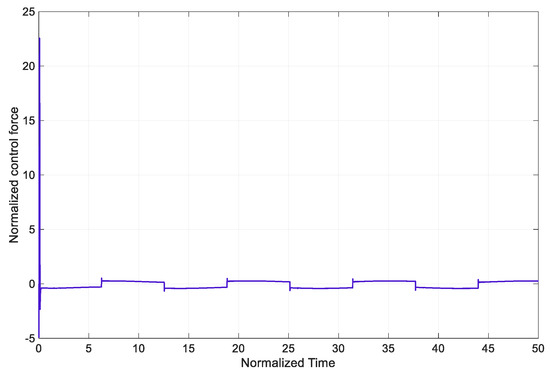
Figure 7.
The control input for the CNT with uncertain parameters and unknown disturbance.
There is rigorous reason behind the smooth control signal of the proposed technique. In the proposed control scheme, the sign function is not applied directly to the system. Instead, only terms containing and the integral of are present, both of which are smooth (refer to Equation (21) in the manuscript). Furthermore, since the controller stabilizes the system in finite time, the sliding surface converges to zero within a finite time. This means that the sign(s_t) function becomes zero after a short period, resulting in reduced or eliminated chattering and vibration during the stabilization process. Hence, the proposed finite-time controller offers two benefits: (a) it stabilizes the system within a finite time, and (b) it reduces or eliminates chattering in the control input signal, thereby reducing vibration in the system.
These results demonstrate the robustness and effectiveness of the proposed super-twisting sliding mode algorithm in maintaining the stability of the CNT system and have significant implications for the design of control systems in practical applications. Discontinuous disturbances can cause instability in the system and lead to poor performance, making it crucial to design a controller that can effectively handle these disturbances. It is noteworthy that many conventional controllers struggle to handle such disturbances, either due to stability criteria that they cannot meet or an increased convergence time. This highlights the importance of the proposed super-twisting sliding mode algorithm, which is able to handle discontinuous disturbances and maintain the stability of the CNT system even in challenging conditions. The results presented in the figures demonstrate the robustness and effectiveness of the proposed algorithm in these scenarios, making it a valuable contribution to the field of control systems design.
4.3. Tracking Control
To examine the efficiency of the proposed control scheme, we set a specific desired state trajectory for the system. This desired state trajectory acts as a benchmark for evaluating the performance of the proposed scheme and allows us to determine how well the system is able to track the desired path. By comparing the actual state of the system with the desired state, we can evaluate the accuracy and reliability of the proposed control strategy in achieving the desired state. This step is crucial in validating the proposed control scheme and provides insight into its ability to track a desired trajectory, a key requirement for many control systems applications.
Figure 8 and Figure 9 show the system’s states and chatter-free control input. The tracking control results demonstrate the proposed control scheme’s ability to reach the desired performance. This is evidenced by the stable and smooth behavior of the system, as well as the control input, which does not exhibit any “chatter” or erratic behavior. This suggests that the proposed control method is effective in controlling the system and producing stable and consistent results, even in the presence of disturbances or other challenging conditions.
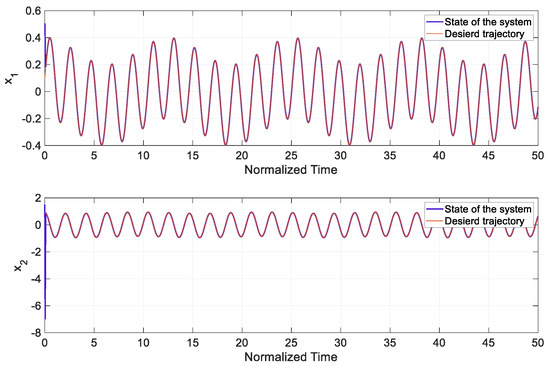
Figure 8.
The states of CNT in tracking control in the presence of uncertain parameters and unknown disturbance.

Figure 9.
The control input for tracking of CNT with uncertain parameters and unknown disturbance.
In summary, this new control method provides a promising solution for the control of CNTs, which are widely used in various fields such as electronics, energy, and medicine, and the ability to control them accurately and efficiently is of great importance.
5. Conclusions
We studied the stabilization and control of CNTs with dynamic parameters and unknown discontinuous uncertainties. The proposed control scheme extends the super-twisting sliding mode control and offers chattering-free and finite-time responses by leveraging the universal approximation capabilities of neural networks. The self-evolving neural network was utilized in the control algorithm to take into account the effects of disturbances and uncertainties, which helped to provide a chattering-free and finite-time response. The Lyapunov stability theorem was used to prove the finite-time convergence and stability of the system. The disturbances and uncertainties were taken into consideration in the stability analysis of the proposed control scheme. The effectiveness of the proposed scheme was assessed through various numerical simulations in different scenarios, including stabilization with time-varying parameters, stabilization in the presence of disturbances, and tracking control. Numerical simulation results confirmed the proposed control technique’s theoretical claims and showed its excellent performance. Given the promising results of the proposed solution in our study, we recommend considering its application in practical scenarios in the future. Also, future enhancements to the proposed controller can include the integration of self-tuning algorithms, making it versatile and adaptable for use in various systems. Also, by incorporating fractional-order elements, the proposed controller can achieve improved performance and accuracy in capturing complex dynamic behaviors, making it more suitable for use in a wider range of systems.
Author Contributions
Conceptualization, F.W.A., M.S.A.-z., Q.Y. and H.J.; methodology, F.W.A., M.S.A.-z., Q.Y. and H.J.; software, F.W.A., M.S.A.-z., Q.Y. and H.J.; validation, F.W.A., M.S.A.-z., Q.Y. and H.J.; formal analysis, F.W.A., M.S.A.-z., Q.Y. and H.J.; writing—original draft preparation, F.W.A., M.S.A.-z., Q.Y. and H.J.; writing—review and editing, F.W.A., M.S.A.-z., Q.Y. and H.J.; supervision, F.W.A., M.S.A.-z., Q.Y. and H.J. All authors have read and agreed to the published version of the manuscript.
Funding
The authors extend their appreciation to the Deputyship for Research and Innovation, Ministry of Education in Saudi Arabia, for funding this research work (Project number INSTR005).
Data Availability Statement
No new data were created.
Conflicts of Interest
The authors declare no conflict of interest.
References
- Anzar, N.; Hasan, R.; Tyagi, M.; Yadav, N.; Narang, J. Carbon Nanotube-A Review on Synthesis, Properties and Plethora of Applications in the Field of Biomedical Science. Sens. Int. 2020, 1, 100003. [Google Scholar] [CrossRef]
- Andrews, R.; Weisenberger, M.C. Carbon Nanotube Polymer Composites. Curr. Opin. Solid State Mater. Sci. 2004, 8, 31–37. [Google Scholar] [CrossRef]
- Endo, M.; Hayashi, T.; Kim, Y.A.; Muramatsu, H. Development and Application of Carbon Nanotubes. Jpn. J. Appl. Phys. 2006, 45, 4883. [Google Scholar] [CrossRef]
- Norizan, M.N.; Moklis, M.H.; Demon, S.Z.N.; Halim, N.A.; Samsuri, A.; Mohamad, I.S.; Knight, V.F.; Abdullah, N. Carbon Nanotubes: Functionalisation and Their Application in Chemical Sensors. RSC Adv. 2020, 10, 43704–43732. [Google Scholar] [CrossRef] [PubMed]
- Wang, X.; Dong, A.; Hu, Y.; Qian, J.; Huang, S. A Review of Recent Work on Using Metal–Organic Frameworks to Grow Carbon Nanotubes. Chem. Commun. 2020, 56, 10809–10823. [Google Scholar] [CrossRef] [PubMed]
- Brozena, A.H.; Kim, M.; Powell, L.R.; Wang, Y. Controlling the Optical Properties of Carbon Nanotubes with Organic Colour-Centre Quantum Defects. Nat. Rev. Chem. 2019, 3, 375–392. [Google Scholar] [CrossRef]
- Mirghaffari, A.; Rahmani, B. Active Vibration Control of Carbon Nanotube Reinforced Composite Beams. Trans. Inst. Meas. Control 2017, 39, 1851–1863. [Google Scholar] [CrossRef]
- Fadaee, M.; Talebitooti, M. Active Vibration Control of Carbon Nanotube-Reinforced Composite Beam Submerged in Fluid Using Magnetostrictive Layers. Mech. Based Des. Struct. Mach. 2022, 50, 799–816. [Google Scholar] [CrossRef]
- Qiu, C.; Zhang, Z.; Zhong, D.; Si, J.; Yang, Y.; Peng, L.-M. Carbon Nanotube Feedback-Gate Field-Effect Transistor: Suppressing Current Leakage and Increasing on/off Ratio. ACS Nano 2015, 9, 969–977. [Google Scholar] [CrossRef]
- Quoc, T.H.; van Tham, V.; Tu, T.M. Active Vibration Control of a Piezoelectric Functionally Graded Carbon Nanotube-Reinforced Spherical Shell Panel. Acta Mech. 2021, 232, 1005–1023. [Google Scholar] [CrossRef]
- Zamfirache, I.A.; Precup, R.-E.; Roman, R.-C.; Petriu, E.M. Policy Iteration Reinforcement Learning-Based Control Using a Grey Wolf Optimizer Algorithm. Inf. Sci. 2022, 585, 162–175. [Google Scholar] [CrossRef]
- Precup, R.-E.; Preitl, S.; Petriu, E.; Bojan-Dragos, C.-A.; Szedlak-Stinean, A.-I.; Roman, R.-C.; Hedrea, E.-L. Model-Based Fuzzy Control Results for Networked Control Systems. Rep. Mech. Eng. 2020, 1, 10–25. [Google Scholar] [CrossRef]
- Chun-Yueh, L.I.N. Fuzzy AHP-Based Prioritization of the Optimal Alternative of External Equity Financing for Start-Ups of Lending Company in Uncertain Environment. Sci. Technol. 2022, 25, 133–149. [Google Scholar]
- Chen, Y.; Chu, B.; Freeman, C.T. Iterative Learning Control for Robotic Path Following with Trial-Varying Motion Profiles. IEEE/ASME Trans. Mechatron. 2022, 27, 4697–4706. [Google Scholar] [CrossRef]
- Suzuki, K. Artificial Neural Networks: Industrial and Control Engineering Applications; BoD–Books on Demand: Norderstedt, Germany, 2011; ISBN 9533072202. [Google Scholar]
- Awodele, O.; Jegede, O. Neural Networks and Its Application in Engineering. In Proceedings of the Informing Science & IT Education Conference (InSITE) 2009, Macon, GA, USA, 12–15 June 2009; pp. 83–95. [Google Scholar]
- Chen, H.; Liu, Z.; Alippi, C.; Huang, B.; Liu, D. Explainable Intelligent Fault Diagnosis for Nonlinear Dynamic Systems: From Unsupervised to Supervised Learning. IEEE Trans. Neural Netw Learn. Syst. 2022. early access. [Google Scholar] [CrossRef]
- Yousefpour, A.; Jahanshahi, H.; Munoz-Pacheco, J.M.; Bekiros, S.; Wei, Z. A Fractional-Order Hyper-Chaotic Economic System with Transient Chaos. Chaos Solitons Fractals 2020, 130, 109400. [Google Scholar] [CrossRef]
- Meghdari, A.; Naderi, D.; Alam, M.R. Neural-Network-Based Observer for Real-Time Tipover Estimation. Mechatronics 2005, 15, 989–1004. [Google Scholar] [CrossRef]
- Chen, S.-B.; Beigi, A.; Yousefpour, A.; Rajaee, F.; Jahanshahi, H.; Bekiros, S.; Martínez, R.A.; Chu, Y. Recurrent Neural Network-Based Robust Nonsingular Sliding Mode Control with Input Saturation for a Non-Holonomic Spherical Robot. IEEE Access 2020, 8, 188441–188453. [Google Scholar] [CrossRef]
- Yasami, A.; Beigi, A.; Yousefpour, A. Application of Long Short-Term Memory Neural Network and Optimal Control to Variable-Order Fractional Model of HIV/AIDS. Eur. Phys. J. Spec. Top. 2022, 231, 1875–1884. [Google Scholar] [CrossRef]
- Xu, C.; Zhang, J.; Yi, M. Optimum Design and Application of Nano-Micro-Composite Ceramic Tool and Die Materials with Improved Back Propagation Neural Network. In Artificial Neural Networks: Industrial and Control Engineering Applications; BoD–Books on Demand: Norderstedt, Germany, 2011; pp. 131–152. [Google Scholar]
- Almakaeel, H.; Albalawi, A.; Desai, S. Artificial Neural Network Based Framework for Cyber Nano Manufacturing. Manuf. Lett. 2018, 15, 151–154. [Google Scholar] [CrossRef]
- Eslami, S.; Jalili, N.; Saeidpourazar, R. A Neural Network-Based Controller for a Piezoelectrically-Actuated Nano/Micromanipulator. In Proceedings of the Smart Materials, Adaptive Structures and Intelligent Systems; ASME: New York, NY, USA, 2008; Volume 43321, pp. 539–546. [Google Scholar]
- Wang, B.; Liu, J.; Alassafi, M.O.; Alsaadi, F.E.; Jahanshahi, H.; Bekiros, S. Intelligent Parameter Identification and Prediction of Variable Time Fractional Derivative and Application in a Symmetric Chaotic Financial System. Chaos Solitons Fractals 2022, 154, 111590. [Google Scholar] [CrossRef]
- Wang, Y.; Wang, Z.; Zhang, X. Robust Active Vibration Suppression of Single-Walled Carbon Nanotube Using Adaptive Sliding-Mode Control and Electrostatic Actuators. J. Vib. Control 2022, 29, 1387–1399. [Google Scholar] [CrossRef]
- Rahmani, B. Adaptive Fuzzy Sliding Mode Control for Vibration Suppression of a Rotating Carbon Nanotube-Reinforced Composite Beam. J. Vib. Control 2018, 24, 2447–2463. [Google Scholar] [CrossRef]
- Yang, W.; Ratinac, K.R.; Ringer, S.P.; Thordarson, P.; Gooding, J.J.; Braet, F. Carbon Nanomaterials in Biosensors: Should You Use Nanotubes or Graphene? Angew. Chem. Int. Ed. 2010, 49, 2114–2138. [Google Scholar] [CrossRef]
- Mall, S.; Chakraverty, S. Chebyshev Neural Network Based Model for Solving Lane–Emden Type Equations. Appl. Math. Comput. 2014, 247, 100–114. [Google Scholar] [CrossRef]
- Wang, B.; Jahanshahi, H.; Dutta, H.; Zambrano-Serrano, E.; Grebenyuk, V.; Bekiros, S.; Aly, A.A. Incorporating Fast and Intelligent Control Technique into Ecology: A Chebyshev Neural Network-Based Terminal Sliding Mode Approach for Fractional Chaotic Ecological Systems. Ecol. Complex. 2021, 47, 100943. [Google Scholar] [CrossRef]
- Lu, K.; Li, T.; Zhang, L. Active Attitude Fault-Tolerant Tracking Control of Flexible Spacecraft via the Chebyshev Neural Network. Trans. Inst. Meas. Control 2019, 41, 925–933. [Google Scholar] [CrossRef]
- Liang, F.; Su, Y. Stability Analysis of a Single-Walled Carbon Nanotube Conveying Pulsating and Viscous Fluid with Nonlocal Effect. Appl. Math. Model. 2013, 37, 6821–6828. [Google Scholar] [CrossRef]
- Fakhrabadi, M.M.S.; Rastgoo, A.; Ahmadian, M.T. Size-Dependent Instability of Carbon Nanotubes under Electrostatic Actuation Using Nonlocal Elasticity. Int. J. Mech. Sci. 2014, 80, 144–152. [Google Scholar] [CrossRef]
- Yousefpour, A.; Vahidi-Moghaddam, A.; Rajaei, A.; Ayati, M. Stabilization of Nonlinear Vibrations of Carbon Nanotubes Using Observer-Based Terminal Sliding Mode Control. Trans. Inst. Meas. Control 2020, 42, 1047–1058. [Google Scholar] [CrossRef]
- Levant, A. Sliding Order and Sliding Accuracy in Sliding Mode Control. Int. J. Control 1993, 58, 1247–1263. [Google Scholar] [CrossRef]
- Moreno, J.A.; Osorio, M. Strict Lyapunov Functions for the Super-Twisting Algorithm. IEEE Trans. Autom. Control 2012, 57, 1035–1040. [Google Scholar] [CrossRef]
Disclaimer/Publisher’s Note: The statements, opinions and data contained in all publications are solely those of the individual author(s) and contributor(s) and not of MDPI and/or the editor(s). MDPI and/or the editor(s) disclaim responsibility for any injury to people or property resulting from any ideas, methods, instructions or products referred to in the content. |
© 2023 by the authors. Licensee MDPI, Basel, Switzerland. This article is an open access article distributed under the terms and conditions of the Creative Commons Attribution (CC BY) license (https://creativecommons.org/licenses/by/4.0/).